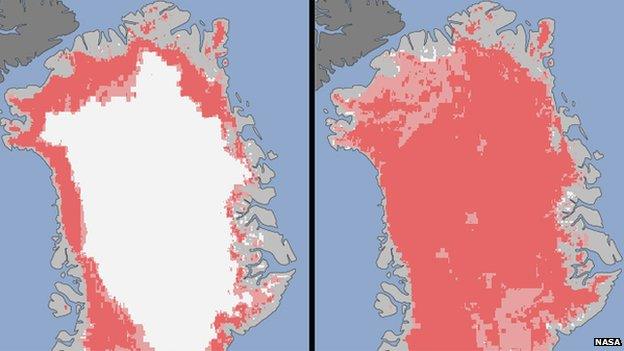Harrabin's Notes: Frozen assets
- Published
In his regular column, BBC environment analyst Roger Harrabin takes a look at the furore surrounding satellite data indicating a dire state of Greenland's ice sheet.

The news of the state of the ice sheet made headlines around the world
Nasa is coming under fire for an alarming headline in a news release warning: "Satellites see Unprecedented Greenland Ice Sheet Melt, external".
A graphic in the same news release gave the impression to the casual viewer that the whole of Greenland's ice had melted.
Neither of these is actually true, as would have been clear to anyone who perused the entire news release or dissected the colour-coded key to the map.
But critics are complaining that readers could have been easily misled by the treatment of the story in the Nasa press office.
The word "unprecedented" is often misused in terms of Arctic ice. In this context it means unprecedented in 30 years of satellite observations, as the press release acknowledged.
But taken on its own in the headline the "unprecedented" reference creates immediate alarm and suggests that man-made climate change is running away with itself. In fact, 30 years in the history of Arctic climate is no more than a blink.
This again was made clear at the bottom of the press release: "Such pronounced melting at Summit and across the ice sheet has not occurred since 1889, according to ice cores analysed by Kaitlin Keegan at Dartmouth College."
Lora Koenig, a Nasa Goddard glaciologist and a member of the research team analyzing the satellite data, said that "ice cores from Summit show that melting events of this type occur about once every 150 years on average. With the last one happening in 1889, this event is right on time".
"But if we continue to observe melting events like this in upcoming years, it will be worrisome."
So we got the context in the end, but the graphic was also unnecessarily scary for the general public. To the casual reader, the shrinking area of white seemed to signify disappearing ice, so the graphic may have given a totally misleading impression that Greenland had become ice-free - even where the ice is 3km thick.
A close reading of the key would have corrected that impression but visual signals like graphics can create powerful emotional reactions that sometimes prove hard to erase through verbal cues.
The news release has attracted criticism from different sides of the climate debate.
Writing in Spiked magazine, Ben Pile complains, external: "In plain sight of the fact that the melting was neither unexpected nor unprecedented, environmental journalists the world over picked up the story and ran with it… What most frustrates climate sceptics is the persistence of such junk science in the public and policy debates."
But a spokesperson for Nasa told BBC News: "Our use of "unprecedented" in the Greenland melting press release was meant to convey the very rare nature of this event, especially in the three decades that scientists have been able to see this phenomenon with satellites.
"This degree of melting has never been seen from satellites before. In preparing our releases, we work closely with our scientists to assure that their results are reported accurately and fully. We are committed to accuracy and clarity in all our communications products."
Mark Brandon, a polar oceanographer at the Open University who specialises in public understanding of science, compiled his own account, external of recent communication on the Arctic.
Dr Brandon told Spiked: "'When I talk to people who don't really know about polar science, they look at that picture of Greenland covered in red, and they think the whole ice sheet is melting."
Dr Brandon, who is personally concerned about the potential impact of man-made climate change on the planet, argues that overstating the problem is not helpful.
The tendency towards hyperbole may stem from the sense of despair among some scientists at the way climate change has disappeared from much of public discourse since the double whammy of Copenhagen and Climategate. They feel that they still have a vital story to tell about the experiment we're conducting on the planet and they're desperate for someone to listen.
They also often feel they are in a street fight with one hand behind their back; Benny Peiser's artfully lurid headlines for the Global Warming Policy Foundation, for instance, can distort the often worthy articles they advertise.
Journalists are trained to reach for the sexiest headline available. But if scientific organisations are to retain credibility, even their media relations need to remain studiously detached.
- Published8 August 2012
- Published14 May 2012